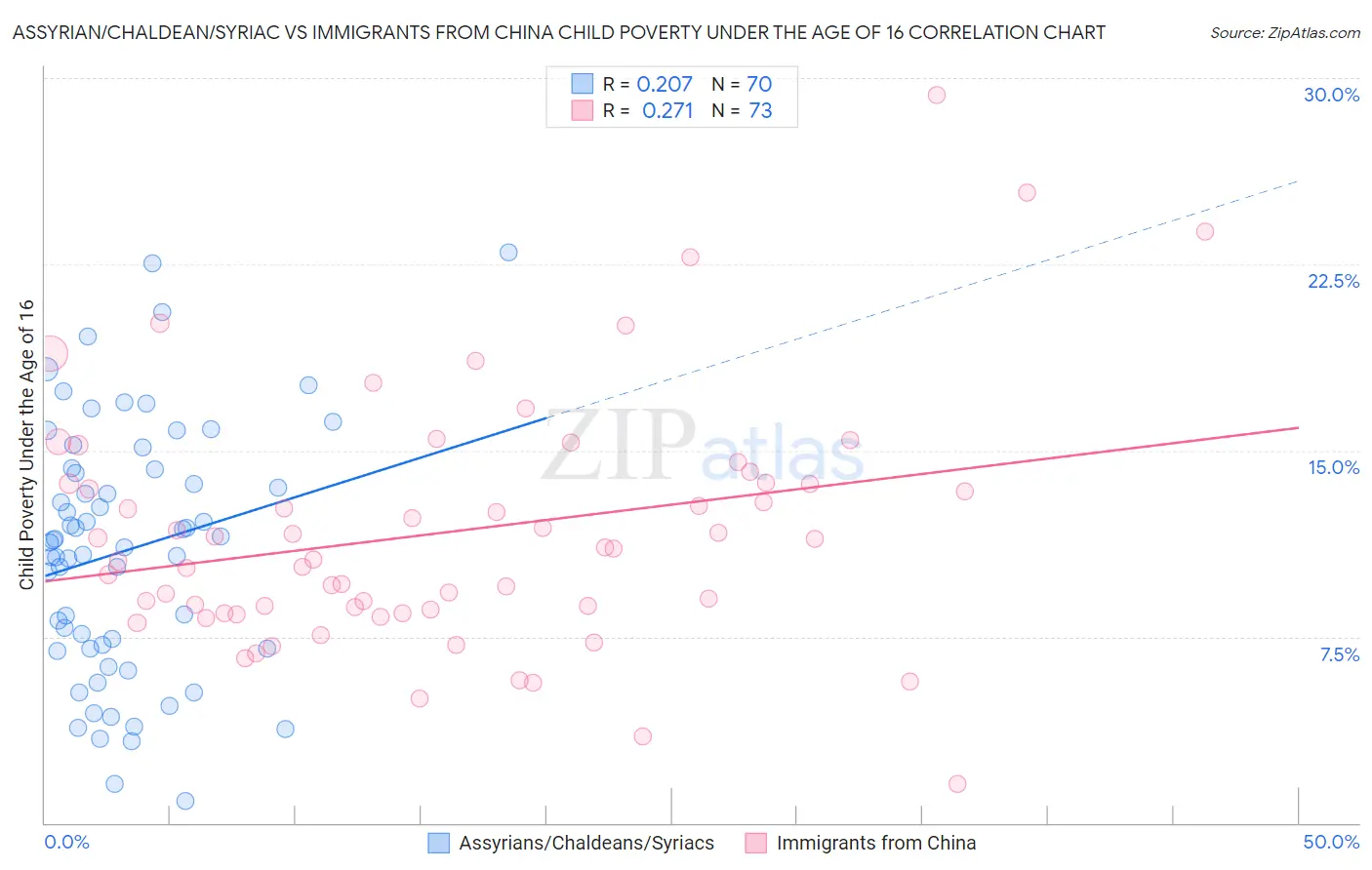Assyrian/Chaldean/Syriac vs Immigrants from China Child Poverty Under the Age of 16
COMPARE
Assyrian/Chaldean/Syriac
Immigrants from China
Child Poverty Under the Age of 16
Child Poverty Under the Age of 16 Comparison
Assyrians/Chaldeans/Syriacs
Immigrants from China
13.3%
CHILD POVERTY UNDER THE AGE OF 16
99.7/ 100
METRIC RATING
28th/ 347
METRIC RANK
13.3%
CHILD POVERTY UNDER THE AGE OF 16
99.8/ 100
METRIC RATING
27th/ 347
METRIC RANK
Assyrian/Chaldean/Syriac vs Immigrants from China Child Poverty Under the Age of 16 Correlation Chart
The statistical analysis conducted on geographies consisting of 109,836,821 people shows a weak positive correlation between the proportion of Assyrians/Chaldeans/Syriacs and poverty level among children under the age of 16 in the United States with a correlation coefficient (R) of 0.207 and weighted average of 13.3%. Similarly, the statistical analysis conducted on geographies consisting of 450,826,325 people shows a weak positive correlation between the proportion of Immigrants from China and poverty level among children under the age of 16 in the United States with a correlation coefficient (R) of 0.271 and weighted average of 13.3%, a difference of 0.24%.

Child Poverty Under the Age of 16 Correlation Summary
| Measurement | Assyrian/Chaldean/Syriac | Immigrants from China |
| Minimum | 0.91% | 1.6% |
| Maximum | 23.0% | 29.3% |
| Range | 22.1% | 27.7% |
| Mean | 11.0% | 11.7% |
| Median | 11.3% | 11.0% |
| Interquartile 25% (IQ1) | 7.0% | 8.5% |
| Interquartile 75% (IQ3) | 14.2% | 13.7% |
| Interquartile Range (IQR) | 7.2% | 5.2% |
| Standard Deviation (Sample) | 5.0% | 5.0% |
| Standard Deviation (Population) | 5.0% | 5.0% |
Demographics Similar to Assyrians/Chaldeans/Syriacs and Immigrants from China by Child Poverty Under the Age of 16
In terms of child poverty under the age of 16, the demographic groups most similar to Assyrians/Chaldeans/Syriacs are Swedish (13.3%, a difference of 0.18%), Turkish (13.4%, a difference of 0.48%), Bolivian (13.2%, a difference of 0.53%), Danish (13.4%, a difference of 0.68%), and Tongan (13.4%, a difference of 0.70%). Similarly, the demographic groups most similar to Immigrants from China are Bolivian (13.2%, a difference of 0.29%), Swedish (13.3%, a difference of 0.42%), Eastern European (13.2%, a difference of 0.71%), Turkish (13.4%, a difference of 0.72%), and Latvian (13.2%, a difference of 0.79%).
| Demographics | Rating | Rank | Child Poverty Under the Age of 16 |
| Bulgarians | 99.9 /100 | #17 | Exceptional 13.0% |
| Cypriots | 99.9 /100 | #18 | Exceptional 13.0% |
| Immigrants | Japan | 99.8 /100 | #19 | Exceptional 13.0% |
| Okinawans | 99.8 /100 | #20 | Exceptional 13.1% |
| Immigrants | Eastern Asia | 99.8 /100 | #21 | Exceptional 13.1% |
| Maltese | 99.8 /100 | #22 | Exceptional 13.1% |
| Indians (Asian) | 99.8 /100 | #23 | Exceptional 13.1% |
| Latvians | 99.8 /100 | #24 | Exceptional 13.2% |
| Eastern Europeans | 99.8 /100 | #25 | Exceptional 13.2% |
| Bolivians | 99.8 /100 | #26 | Exceptional 13.2% |
| Immigrants | China | 99.8 /100 | #27 | Exceptional 13.3% |
| Assyrians/Chaldeans/Syriacs | 99.7 /100 | #28 | Exceptional 13.3% |
| Swedes | 99.7 /100 | #29 | Exceptional 13.3% |
| Turks | 99.7 /100 | #30 | Exceptional 13.4% |
| Danes | 99.7 /100 | #31 | Exceptional 13.4% |
| Tongans | 99.7 /100 | #32 | Exceptional 13.4% |
| Asians | 99.6 /100 | #33 | Exceptional 13.5% |
| Russians | 99.6 /100 | #34 | Exceptional 13.5% |
| Lithuanians | 99.6 /100 | #35 | Exceptional 13.5% |
| Immigrants | Northern Europe | 99.6 /100 | #36 | Exceptional 13.6% |
| Immigrants | Bolivia | 99.6 /100 | #37 | Exceptional 13.6% |